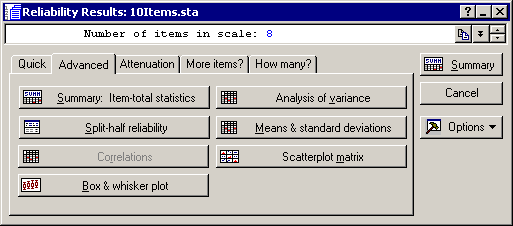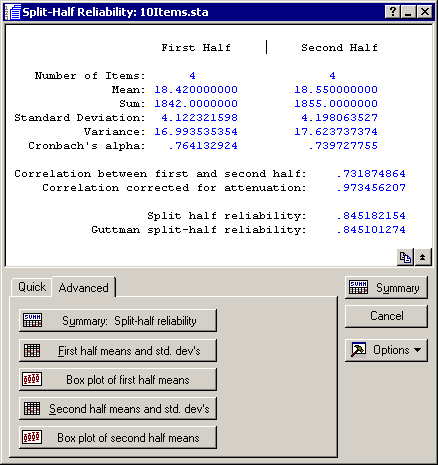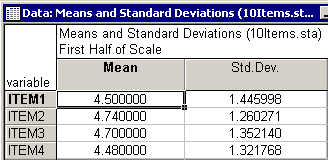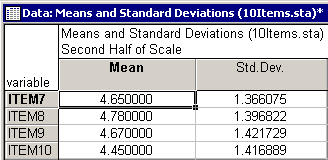Example 2: Split-Half Reliability
Continuing from Example 1, suppose you want to use the questionnaire to assess the success of a new advertisement campaign. In that case you may want to divide the 8-item scale into two halves that can be used before and after respondents have been exposed to the new commercials. You can split the scale "in the middle," that is, make up one sum scale of items 1 through 4, and the other scale of items 7 through 10.
- Specifying the analysis
- In the
Reliability and Item Analysis Startup Panel, click the Split-half reliability button to display the standard variable selection dialog. Select variables Item1-Item4 for the First half and variables Item7-Item10 for the Second half and then click the OK button. Also on the
Advanced tab select NO in the Correlation matrix box.
Click the OK button on the Startup Panel to display the Reliability Results dialog.
- Reviewing the results
- Now, the Split-half reliability button is available on the
Reliability Results - Advanced tab.
Click the Split-half reliability button to display the Split-Half Reliability results dialog and then click on the Advanced tab.
As you can see in the summary box, the estimate of reliability based on the Split half reliability formula in the Introductory Overview is practically identical to the internal consistency estimate (Cronbach's alpha - see Example 1). The Guttman split-half reliability reported on this dialog can be interpreted as the Cronbach's alpha that would result if you treat the two halves of the scales as two single items of a two-item overall scale. Again, this estimate is very similar to the other reliability coefficients.
Click the First half means and std. dev's button to display the Means and Standard Deviations spreadsheet for the first half of the scale.
Finally, click the Second half means and std. dev's button to display the Means and Standard Deviations spreadsheet for the second half of the scale.
It appears from the Means and Standard Deviations spreadsheets that the means and standard deviations for the two halves of the scale are also comparable. Therefore, you may use these two halves as equivalent scales to measure prejudice against foreign-made cars.





